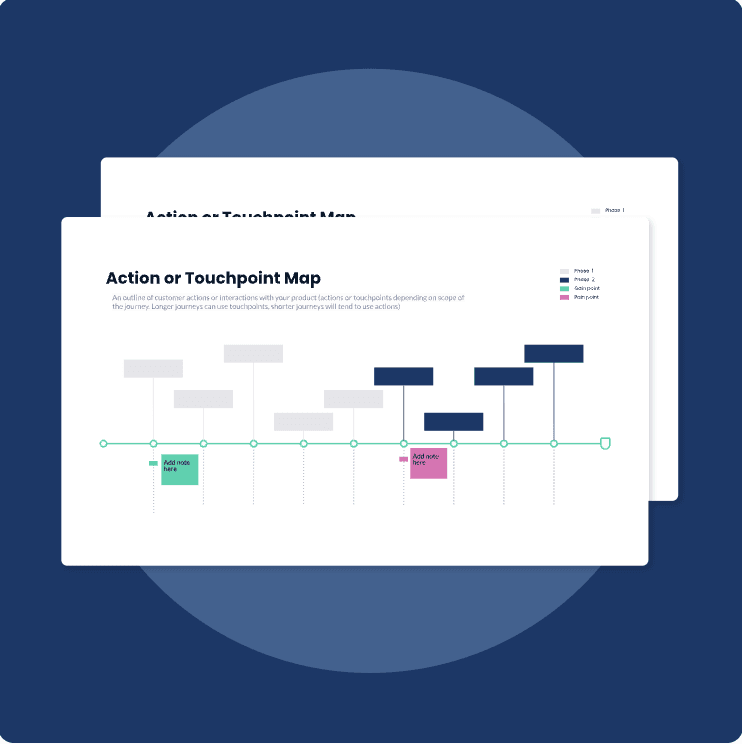Updated: July 31, 2025- 22 min read
Google Glass, Segways, even the QR code when it first appeared…These were labeled as “bad innovations,” dismissed as failures or fads. But are they, really?
Sure, they faced criticism when they launched, but they also had something else: potential.
Each of these innovations struggled not just due to inherent flaws but perhaps because their path to product adoption wasn’t clear-cut. Things are not always as black-and-white as a good or bad innovation — despite what trendy LinkedIn posts may claim. The reality is more nuanced, and how they were introduced to the market plays a part.
The truth is even the best products need a streamlined path to adoption. Understanding the product adoption process and engineering it correctly can make all the difference between an innovation that flops and one that thrives. Let's dive in.
Free Customer Journey Map
Put yourself in your customers’ shoes to find the problems in your user experience (and uncover opportunities to solve them).
Download here
What Is a New Product Adoption Process?
I see kind of the role of product managers as trying to build consensus around the right decisions, using inputs from peers, using inputs from data, from research, from their own product sense, and then trying to build consensus as quickly as possible.
— Jeremy Forrester, VP of Product at Twitch, on The Product Podcast
The product adoption process is the journey users go through to start using a new product. It begins with people first hearing about the product and ends when they become loyal users, integrating it into their daily lives. This process has several stages — awareness, interest, evaluation, trial, and adoption — each requiring tailored strategies to move users forward.
You might hear common product management terms like user onboarding, user retention, user flow, product-market fit, and user engagement when discussing product adoption. These terms highlight key areas of focus within the process, like getting users comfortable with the product (onboarding), retaining them (churn), and measuring how well the product meets user needs (product-market fit). That is why the customer adoption process is so crucial in Product-led Marketing.
The concept of product adoption has been around for decades. It became a formal theory in the 1960s, thanks to Everett Rogers' concept of Diffusion of Innovations, which outlined how new ideas spread across different types of users, from early adopters to laggards.
Today, companies like Airbnb, Spotify, and Slack understand the importance of the product adoption process. Their product marketing teams focus on guiding users at every stage to ensure a smooth transition from initial interest to full adoption. This process — not just a ‘good or bad idea’ — makes all the difference between a product that people abandon and one they truly embrace.
The Product Adoption Curve: Understanding User Behavior
The technology adoption curve, developed by Everett M. Rogers in his theory of Diffusion of Innovations, helps explain how different groups of users approach a new product. This curve is divided into five categories: Innovators, Early Adopters, Early Majority, Late Majority, and Laggards.

Understanding where your users fall on this curve allows you to craft targeted strategies for each group. Innovators and Early Adopters, for example, are more willing to take risks and explore new technologies, while the Early Majority seeks proven value before making a commitment. By aligning your product marketing with these behaviors, you can create a smoother, more effective adoption process.
The 5 Product Adoption Stages

Awareness [1]: This is where users first hear about the product. It’s the initial introduction—maybe through an ad, a social media post, or a recommendation from a friend. At this stage, they know the product exists but may not fully understand what it does or how it benefits them.
Interest [2]: Now that users know about the product, they start to get curious. They might read up on it, watch a demo, or browse the website to learn more. The goal here is to spark genuine interest by showing how the product can solve a problem or add value to their life.
Evaluation [3]: This is where users weigh the pros and cons. They compare the product to alternatives, read reviews, or ask for opinions. It’s a critical stage because users decide whether the product is worth trying, so clear information and real-life success stories help make the case.
Trial [4]: Users take the product for a test drive. They might sign up for a free trial, use a demo version, or try out basic features. The trial is about proving the product’s worth, so making it as smooth and helpful as possible can tip the scales toward full adoption.
Adoption [5]: The user commits. They integrate the product into their routine, whether that means upgrading to a paid plan, using it regularly, or recommending it to others. This stage is where the product becomes a part of their daily life, making retention strategies crucial to maintaining engagement and loyalty.
Best Practices for Product Adoption Process

In this guide, we'll break down each stage of the product adoption process and explore how you can increase adoption rates at every step.
For each stage, you'll find strategies, tips, and best practices that are practical and easy to apply. By the end, you'll have a clear understanding of what drives users from awareness to full adoption.
Whether you're launching a new product or refining your ongoing go-to-market approach, this content will give you the tools to help users embrace your product more effectively.
1. Strategies for Building New Product Awareness
In the awareness stage, the goal is simple: get your product noticed. But it’s not just about visibility — it’s about reaching the right audience and leaving a lasting impression.
Product marketing managers in this stage often use targeted channels, build partnerships with influencers, and create urgency to make a memorable impact. The strategies aim to attract initial attention, but they’re also focused on connecting with the right users who are most likely to find value in the product.
Strategies for Building Awareness
Using Targeted Channels: Understanding where potential users spend their time online is crucial. Whether it’s LinkedIn, specific forums, or niche communities, it’s beneficial to prioritize these channels. Tools like LinkedIn Ads, Reddit Ads, or the Google Display Network offer precise targeting, helping companies reach the most relevant audience.
Partnering with Influencers in Your Niche: Collaborating with trusted thought leaders in the industry can be highly effective. Co-branded webinars, joint white papers, or simple mentions in their content can create significant buzz, especially when influencers align with the product’s mission.
Creating Urgency with Exclusive Access: People often respond well to exclusivity, so offering early access or beta invites can be a powerful way to generate interest. PM tools like LaunchRock and Product Hunt support this approach.
Tips for Messaging and Content
Clarifying the Problem Solved: Clear messaging that connects directly with the user’s pain points can make a strong impact. The language that is relatable and free of jargon resonates more effectively — shifting from broad claims like “Increase workforce productivity” to specifics like “Less busywork, more meaningful work” can help.
Using Storytelling: Stories tend to be more memorable, especially when they reflect the real-world struggles of target users. Many campaigns highlight relatable stories or feature user testimonials that showcase how the product addresses specific challenges.
Creating Short, Visual Content: Short videos, GIFs, and infographics make complex information more digestible. Tools like Canva, Loom, or Biteable offer options for visuals that quickly convey the product’s value.
Best Practices for Tools and Formats
Testing Messaging with A/B Tests: Awareness often involves exploring what resonates best with users. Trying different messages, images, and CTAs can provide insights into what drives clicks and conversions. Tools like Optimizely or VWO help streamline this process.
Creating Focused Landing Pages: Specific landing pages tailored to each campaign or audience segment can enhance the user experience. These pages often highlight the problem being solved, the unique value offered, and an enticing call-to-action, such as a demo or free trial. Tools like Unbounce and Instapage simplify landing page creation.
Advanced Messaging Strategies
Running ‘Problem Awareness’ Campaigns: Educating the audience about the problem itself before pitching the solution can prove effective. Ads or content campaigns that first address the problem generally can build curiosity and prepare users to see the product as the right fit.
Applying Contextual Targeting: Ads delivered based on the content users are already consuming are more likely to resonate. For instance, users reading about improving workplace efficiency are more likely to engage with ads promoting productivity tools.
Aligning Messaging with User Personas: Different segments often require tailored messaging. For example, when marketing project management software, startups, and large enterprises may need different messages to address their specific needs.
In the awareness stage, visibility is key, but precision matters just as much. These practices help companies not only gain attention but also make a meaningful impression that sets the stage for deeper engagement.
2. Practical Tips to Spark Interest
In the interest stage, users are already aware of the product. Therefore, curiosity needs to be nurtured further.
Product teams in this stage aim to deepen user engagement by providing valuable info, sparking a desire to learn more, and encouraging users to take the next step. The strategies here are centered around trust, value, and guidance.
Strategies for Generating Interest
Providing Engaging Educational Content: At this stage, users are seeking to understand the product better, so educational content that explains its value is important. Detailed blog posts, explainer videos, and webinars that highlight use cases or success stories work well. Tools like HubSpot and CoSchedule offer content planning and promotion features to ensure users find the right resources.
Offering Interactive Experiences: Interactive content can significantly boost user interest. Features like quizzes, product demos, or self-assessment tools let users explore the product’s benefits in a hands-on way. Tools such as Typeform or Outgrow are effective for creating these experiences.
Using Email Nurture Campaigns: Interest often requires nurturing over time. Email campaigns that offer valuable insights, tips, or product updates can maintain engagement and build anticipation. Tools like Mailchimp and ActiveCampaign help create targeted email sequences that keep users interested without being pushy.
Tips for Messaging and Content
Showcasing Real-World Use Cases: Users often connect better with relatable examples. Highlighting specific ways your product solves common problems or meets specific needs can be very persuasive. Case studies, customer stories, and testimonials can be used effectively in emails, blogs, or videos.
Building Credibility with Social Proof: Reviews, testimonials, or endorsements from recognized brands help users feel more comfortable exploring the product further. Including these elements on the website, in ads, or within email campaigns can strengthen interest.
Creating Engaging Product Overviews: Short product videos, feature breakdowns, and FAQ pages that clearly explain what the product does, how it works, and why it matters can enhance user understanding. Tools like Wistia and Loom allow for easy creation and sharing of engaging video content.
Best Practices for Tools and Formats
Implementing Retargeting with Personalized Content: Retargeting ads tailored to a user’s specific interests can re-engage them effectively. For example, if a user views a specific feature on your website, ads should emphasize that feature. Tools like AdRoll and Facebook Ads support this type of targeted retargeting.
Utilizing Webinar Platforms for Deeper Engagement: Webinars provide a more detailed, interactive way for users to explore the product. They offer real-time engagement, Q&A, and direct demonstrations of key features. Platforms like Zoom or Demio are ideal for hosting engaging, interactive sessions.
Using Dynamic Landing Pages: Interest-driven landing pages should adapt to user behavior, offering tailored messages based on what users have already shown interest in. Tools like Unbounce or Instapage offer dynamic landing page creation to enhance engagement.
Advanced Messaging Strategies
Running ‘How-To’ Campaigns: Instead of just describing features, guide users on how to achieve specific outcomes with your product. For example, campaigns like “How to Improve Team Collaboration in 30 Days” showcase how the product can be an enabler, making the benefit more tangible.
Creating ‘Feature Spotlight’ Series: Instead of overwhelming users with all features at once, introduce one major feature at a time. These mini-campaigns, delivered through email or social media, focus on a single benefit and allow users to digest the information more easily.
Aligning Communication with User Flow: Tailoring content based on user segments and where they are in the interest phase can drive better engagement. For instance, new users might need an introductory guide, while returning users might appreciate advanced tips or a deeper dive into features.
In the interest stage, the focus shifts from capturing attention to maintaining it. These strategies, tips, and best practices are designed to guide users deeper into the process.
3. Evaluation Stage of Product Adoption Curve
In the evaluation stage, users are weighing their options. They’ve shown genuine interest and are now comparing your product to others.
At this point, it’s all about building confidence by providing clear, transparent, and helpful information that answers users’ questions. Similar to the previous stage, the focus is on value and helping users decide whether your product is the right fit for their needs without pushing for a commitment — yet.
Strategies for Supporting Evaluation
Providing In-Depth Product Comparisons: Many businesses create comparison pages that highlight the differences between their product and competitors. This type of content allows users to see how your product stacks up in terms of features, product pricing, and benefits. Tools like G2 or Capterra are great for gathering customer reviews and insights that can be integrated into these comparison pages.
Offering ROI Calculators and Value Assessments: Tools like calculators or assessments help users understand the tangible benefits of your product. For example, an ROI calculator can show potential cost savings or productivity gains, making it easier for users to see how your product provides value. Platforms like Outgrow or HubSpot’s ROI calculator offer customizable calculators.
Sharing Case Study Interviews: Case studies that dive into how your product has solved problems for other customers can be powerful. The focus here should be on relatable success stories that align with the user's industry or needs, providing clear evidence of the product’s impact.
Tips for Messaging and Content
Highlighting Key Benefits, Not Just Features: While it’s tempting to list features, users in the evaluation stage want to understand the benefits behind those features. For example, instead of simply mentioning "automated reporting," explain how it saves time and improves accuracy in decision-making.
Showcasing Social Proof and Customer Success: User testimonials, awards, and industry recognition can provide the validation users need to move forward. It’s helpful to display these elements prominently on the website or in email campaigns.
Offering Transparent Pricing Information: Many users consider pricing a key factor in the evaluation stage. Providing clear, upfront pricing information, along with potential add-ons or options, can build trust. Use tools like Recurly or Chargebee to create easy-to-understand pricing models.
Best Practices for Tools and Formats
Using Personalized Email Sequences: Personalized emails based on user behavior, such as which features they’ve shown interest in or what content they’ve downloaded, can encourage deeper evaluation. Tools like ActiveCampaign and HubSpot enable this kind of segmentation and personalization.
Leveraging Demo Videos: Users in the evaluation stage often benefit from short, detailed videos that highlight specific features or solutions. These videos can be used on landing pages, in emails, or as part of comparison content. Platforms like Wistia or Vimeo support high-quality video content for user evaluation.
Creating Feature Guides or eBooks: Detailed guides or eBooks that explain how to use specific features or achieve particular results with your product can help users evaluate whether it meets their needs. Use tools like Canva or Adobe InDesign to create visually appealing content.
Advanced Messaging Strategies
Running 'Success Story' Campaigns: These campaigns focus on sharing stories of customers who faced similar challenges and found success using the product. Highlighting these stories in emails, on the website, or through retargeting ads can help users envision their own success with the product.
Using Tailored Landing Pages for Specific Segments: It’s helpful to create landing pages tailored to different user personas, showcasing features and benefits most relevant to their needs. Tools like Instapage or Unbounce offer segmentation options for personalized user experiences.
Offering a ‘Peek Under the Hood’ with Detailed Explainers: At this stage, users often appreciate in-depth content that provides a closer look at how the product works. Detailed explainers, whether in video or article form, give users the transparency needed to make a more informed decision.
In the evaluation stage, the goal is to help users feel confident about the decision they’re making. The strategies, tips, and best practices here aim to provide the information users need to make an informed choice—without pushing them to try the product just yet. When done well, this stage sets the foundation for a successful transition into the trial phase.
4. Trial Phase of Product Adoption Lifecycle
In the trial phase, users are finally getting hands-on with the product. At this stage, it’s crucial to provide a seamless experience that clearly demonstrates the product’s value.
Businesses focus on making it easy for users to explore features, understand the product’s potential, and see tangible results quickly. The aim is to convert users from testers to committed adopters by offering guidance, support, and a clear path to success.
Strategies for a Successful Trial Experience
Designing a Guided Onboarding Flow: A clear, step-by-step onboarding process can make a big difference. Many companies use interactive walkthroughs that introduce users to key features as soon as they start their trial. Tools like Userpilot and Pendo allow for easy creation of personalized onboarding flows.
Offering In-App Messaging and Tooltips: Users often need help navigating the product during the trial, so real-time guidance through in-app messages or tooltips can be effective. These messages can offer tips, highlight benefits, and encourage users to try out specific features. Tools like Intercom or Drift make it easy to integrate in-app communication.
Providing Quick Wins Early On: The best trial experiences let users achieve quick wins — small but meaningful results — soon after they start using the product. This helps users understand the product’s value right away. For example, offering default templates, pre-filled data, or sample projects can make it easier for users to get started. This is how these product marketing examples do wonders.
Tips for Messaging and Content
Using Clear, Actionable Prompts: During the trial, users need encouragement to explore more features. Messages like “Try adding a task to your calendar” or “Upload a file to see how sharing works” guide users without overwhelming them.
Sharing ‘How-To’ Videos for Specific Features: Short, focused videos that explain individual features help users understand the product better. These videos can be embedded directly into the user interface or shared through follow-up emails. Tools like Loom or Wistia are great for creating and sharing these videos.
Using Email Sequences to Support Users: Tailored email campaigns during the trial can provide helpful tips, highlight different features, and address common questions. Email tools like Mailchimp or HubSpot can be used to automate and personalize these campaigns.
Best Practices for Tools and Formats
Creating a Product Dashboard: Product designers know that many users benefit from a dashboard that summarizes their progress during the trial. It might show which features they’ve tried, how far they’ve come, and what’s left to explore. Tools like Mixpanel or Amplitude provide analytics that can help design an effective trial dashboard.
Using Checklists and Progress Bars: Visual elements like checklists and progress bars help users track their progress during the trial. These elements can guide users toward completing key steps and achieving a sense of progress. Tools like Trello or ClickUp allow for easy checklist creation within the product interface.
Offering Live Chat for Instant Support: Real-time support during the trial phase can make a significant difference in user satisfaction. Users often have questions that, if answered quickly, can keep them engaged. Tools like Zendesk or Olark offer live chat options to support trial users.
Advanced Messaging Strategies
Running ‘Feature Focus’ Campaigns: While users are in the trial, sending short email campaigns that spotlight specific features can keep them engaged. These emails highlight one feature at a time, explaining its benefits and offering tips for trying it out.
Using Behavioral Triggers to Guide Users: Behavioral triggers—like sending an email when a user engages with a specific feature for the first time—can encourage deeper exploration. Tools like Intercom and Pendo allow for behavioral tracking that informs targeted messaging.
Providing Gamified Elements: Gamification, such as rewarding users with badges or progress points for trying specific features, can enhance engagement during the trial. Tools like Bunchball or Gamify offer gamification solutions that can be integrated into the trial experience.
In the trial phase, the focus is on making users feel confident about the product’s value and ease of use. These strategies, tips, and best practices aim to create an engaging and rewarding trial experience.
5. Customer Adoption Stage
In the adoption phase, users commit to using the product regularly. It’s where initial interest and exploration merge into a tangible engagement.
The focus here is on reinforcing the value users have already experienced, driving deeper usage, and ensuring satisfaction. Businesses at this stage rely heavily on data to track product adoption metrics, measure user retention, and refine product-led marketing efforts.
Strategies for Sustaining Adoption
Tracking Product Usage Metrics: To understand how users are engaging with the product, it’s crucial to track metrics like Daily Active Users (DAU), Monthly Active Users (MAU), and Feature Adoption Rates. These metrics help identify which features are most popular and which need improvement. Tools like Mixpanel and Amplitude offer in-depth product analytics to help refine the product adoption strategy.
Creating Personalized In-App Experiences: Personalization keeps users engaged by tailoring the product experience based on individual preferences and behaviors. This can include personalized dashboards, saved settings, or suggested features. Tools like Userpilot and Pendo make it easy to deliver tailored in-app experiences that align with user needs.
Implementing Retention Campaigns: Retention campaigns focus on keeping users engaged over time. These can include re-engagement emails, feature updates, and new use cases that keep users interested. Email marketing platforms like ActiveCampaign or Mailchimp help automate and personalize these efforts.
Tips for Messaging and Content
Value Through Feature Success Stories: Sharing user success stories reinforces the product’s impact and inspires continued use. These stories can be shared through in-app messages, email newsletters, or on the website to remind users of the feature’s benefits.
Using Data to Drive Engagement: Data insights can reveal which features users find most valuable. Sharing this information with users—like “Users who use Feature X achieve a 30% higher success rate” — can encourage adoption of underused features.
Offering Ongoing Education: Regular educational content, such as advanced tutorials, feature updates, and use case webinars, helps users get more out of the product. Platforms like Loom or Wistia are effective for creating engaging video tutorials that can be integrated into email campaigns or product dashboards.
Best Practices for Tools and Formats
Using NPS and User Feedback Surveys: Tools like SurveyMonkey or Typeform can help gather user feedback, including Net Promoter Score (NPS), satisfaction surveys, or feature requests. Understanding user sentiment and needs can drive product improvements and further adoption.
Implementing Feature Announcements In-App: When rolling out new features or updates, use in-app announcements to notify users directly. Highlighting how the update benefits users and why they should try it encourages ongoing engagement. Tools like Chameleon and Appcues can help with in-app announcements.
Measuring Adoption Metrics: Monitoring retention metrics like Churn Rate, Customer Lifetime Value (CLV), and Retention Rate is critical. These metrics provide a clear picture of how well users are sticking with the product and where there might be potential drop-offs. Tools like ProfitWell and Baremetrics offer detailed insights into user retention.
Advanced Messaging Strategies
Promoting ‘Power User’ Features: Power users often discover advanced features that provide significant value. Promoting these features to other users, with guidance on how to use them, can drive deeper adoption. Messaging campaigns that target users who are ready to advance can be highly effective.
Segmenting Users for Targeted Engagement: Segmenting users based on behavior and engagement level allows for more personalized follow-up. For example, new adopters might need extra support, while experienced users could benefit from advanced tips or exclusive access to beta features. Tools like HubSpot or Intercom offer user segmentation options to support targeted engagement.
Using Product-Led Marketing Metrics to Refine Strategy: Metrics like Activation Rate, Time to Value, and Adoption Rate can inform future marketing efforts. These insights help align marketing with the product’s strengths, ensuring that the message resonates with both new and existing users.
In the adoption phase, the focus shifts from attracting users to keeping them engaged and satisfied over time. The strategies, tips, and best practices here emphasize the importance of data-driven decisions, personalized experiences, and continuous support.
Product Adoption Process: Final Thoughts
Adopting a product is a journey, just like any other meaningful endeavor in life. You’re the user yourself, you should have a solid basis to understand this — it takes time, patience, and a willingness to adapt.
The key to success lies in understanding each stage, refining strategies, and consistently providing value to users. Whether you’re launching a new product or improving an existing one, focus on clarity, engagement, and results.
Remember, just like personal growth, product adoption thrives on persistence and learning. Now’s the time to take action — evaluate your current strategies, make changes, and watch your efforts being awarded in adoption.
Product Launch Checklist
Launch is a critical time that can make the difference between product success and failure. Use this checklist to make sure nothing falls through the cracks.
DOWNLOAD CHECKLIST
Updated: July 31, 2025





